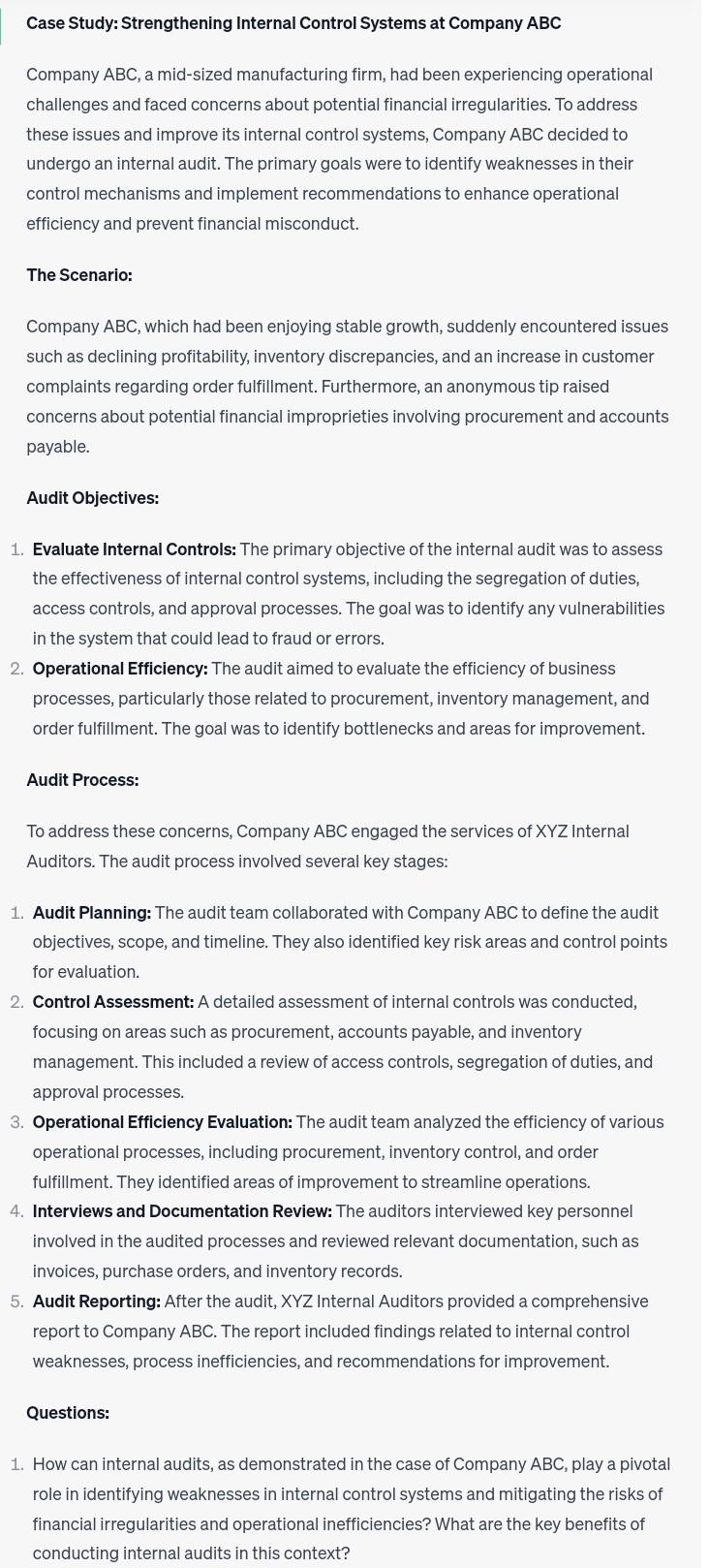Answered step by step
Verified Expert Solution
Question
1 Approved Answer
Case Study: Strengthening Internal Control Systems at Company ABC Company ABC, a mid-sized manufacturing firm, had been experiencing operational challenges and faced concerns about potential

Case Study: Strengthening Internal Control Systems at Company ABC Company ABC, a mid-sized manufacturing firm, had been experiencing operational challenges and faced concerns about potential financial irregularities. To address these issues and improve its internal control systems, Company ABC decided to undergo an internal audit. The primary goals were to identify weaknesses in their control mechanisms and implement recommendations to enhance operational efficiency and prevent financial misconduct. The Scenario: Company ABC, which had been enjoying stable growth, suddenly encountered issues such as declining profitability, inventory discrepancies, and an increase in customer complaints regarding order fulfillment. Furthermore, an anonymous tip raised concerns about potential financial improprieties involving procurement and accounts payable. Audit Objectives: 1. Evaluate Internal Controls: The primary objective of the internal audit was to assess the effectiveness of internal control systems, including the segregation of duties, access controls, and approval processes. The goal was to identify any vulnerabilities in the system that could lead to fraud or errors. 2. Operational Efficiency: The audit aimed to evaluate the efficiency of business processes, particularly those related to procurement, inventory management, and order fulfillment. The goal was to identify bottlenecks and areas for improvement. Audit Process: To address these concerns, Company ABC engaged the services of XYZ Internal Auditors. The audit process involved several key stages: 1. Audit Planning: The audit team collaborated with Company ABC to define the audit objectives, scope, and timeline. They also identified key risk areas and control points for evaluation. 2. Control Assessment: A detailed assessment of internal controls was conducted, focusing on areas such as procurement, accounts payable, and inventory management. This included a review of access controls, segregation of duties, and approval processes. 3. Operational Efficiency Evaluation: The audit team analyzed the efficiency of various operational processes, including procurement, inventory control, and order fulfillment. They identified areas of improvement to streamline operations. 4. Interviews and Documentation Review: The auditors interviewed key personnel involved in the audited processes and reviewed relevant documentation, such as invoices, purchase orders, and inventory records. 5. Audit Reporting: After the audit, XYZ Internal Auditors provided a comprehensive report to Company ABC. The report included findings related to internal control weaknesses, process inefficiencies, and recommendations for improvement. Questions: 1. How can internal audits, as demonstrated in the case of Company ABC, play a pivotal role in identifying weaknesses in internal control systems and mitigating the risks of financial irregularities and operational inefficiencies? What are the key benefits of conducting internal audits in this context
Step by Step Solution
There are 3 Steps involved in it
Step: 1

Get Instant Access to Expert-Tailored Solutions
See step-by-step solutions with expert insights and AI powered tools for academic success
Step: 2

Step: 3

Ace Your Homework with AI
Get the answers you need in no time with our AI-driven, step-by-step assistance
Get Started


